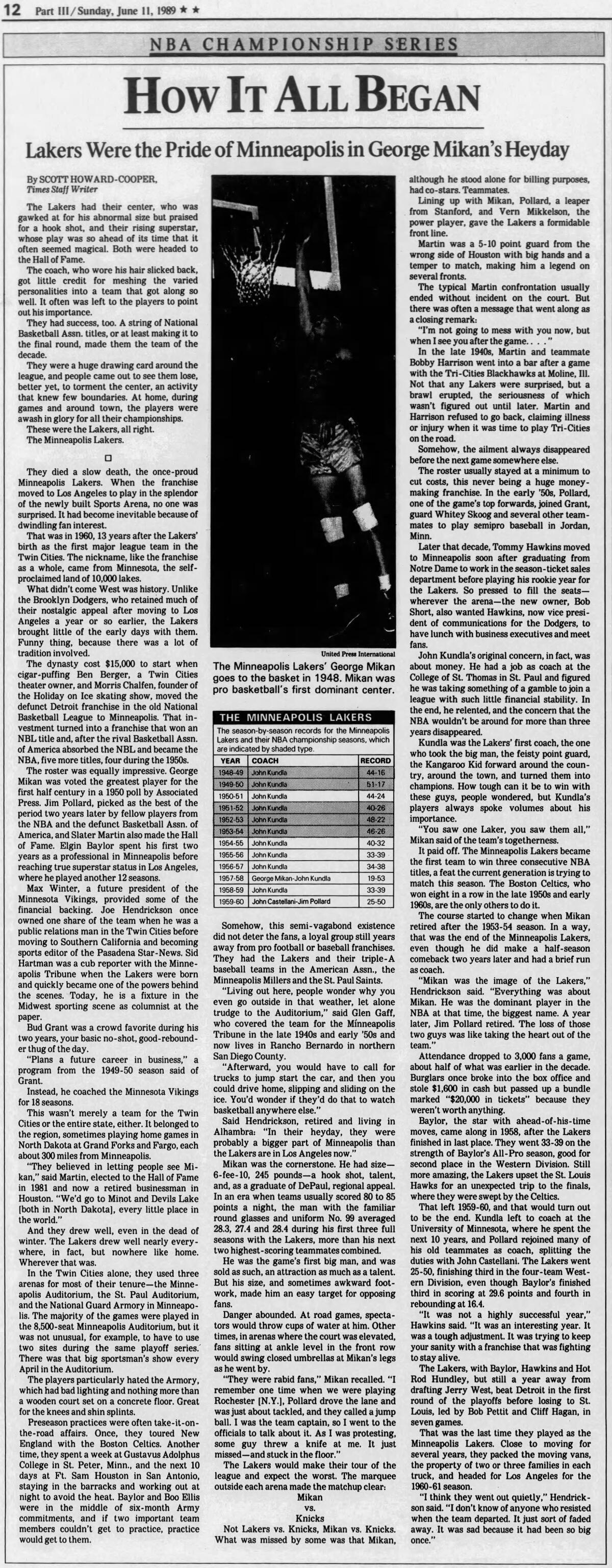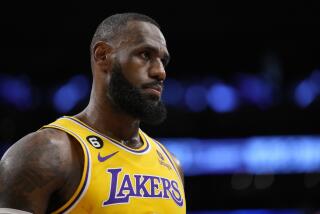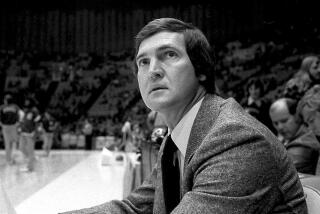How it all began | Lakers were the pride of Minneapolis in George Mikan’s heyday
The Lakers had their center, who was gawked at for his abnormal size but praised for a hook shot, and their rising superstar, whose play was so ahead of its time that it often seemed magical. Both were headed to the Hall of Fame.
The coach, who wore his hair slicked back, got little credit for meshing the varied personalities into a team that got along so well. It often was left to the players to point out his importance.
They had success, too. A string of National Basketball Assn. titles, or at least making it to the final round, made them the team of the decade.
They were a huge drawing card around the league, and people came out to see them lose, better yet, to torment the center, an activity that knew few boundaries. At home, during games and around town, the players were awash in glory for all their championships.
These were the Lakers, all right.
The Minneapolis Lakers.
They died a slow death, the once-proud Minneapolis Lakers. When the franchise moved to Los Angeles to play in the splendor of the newly built Sports Arena, no one was surprised. It had become inevitable because of dwindling fan interest.
That was in 1960, 13 years after the Lakers’ birth as the first major league team in the Twin Cities. The nickname, like the franchise as a whole, came from Minnesota, the self-proclaimed land of 10,000 lakes.
What didn’t come West was history. Unlike the Brooklyn Dodgers, who retained much of their nostalgic appeal after moving to Los Angeles a year or so earlier, the Lakers brought little of the early days with them. Funny thing, because there was a lot of tradition involved.
The dynasty cost $15,000 to start when cigar-puffing Ben Berger, a Twin Cities theater owner, and Morris Chalfen, founder of the Holiday on Ice skating show, moved the defunct Detroit franchise in the old National Basketball League to Minneapolis. That investment turned into a franchise that won an NBL title and, after the rival Basketball Assn. of America absorbed the NBL and became the NBA, five more titles, four during the 1950s.
The roster was equally impressive. George Mikan was voted the greatest player for the first half century in a 1950 poll by Associated Press. Jim Pollard, picked as the best of the period two years later by fellow players from the NBA and the defunct Basketball Assn. of America, and Slater Martin also made the Hall of Fame. Elgin Baylor spent his first two years as a professional in Minneapolis before reaching true superstar status in Los Angeles, where he played another 12 seasons.
Max Winter, a future president of the Minnesota Vikings, provided some of the financial backing. Joe Hendrickson once owned one share of the team when he was a public relations man in the Twin Cities before moving to Southern California and becoming sports editor of the Pasadena Star-News. Sid Hartman was a cub reporter with the Minneapolis Tribune when the Lakers were born and quickly became one of the powers behind the scenes. Today, he is a fixture in the Midwest sporting scene as columnist at the paper.
Bud Grant was a crowd favorite during his two years, your basic no-shot, good-rebounder thug of the day.
“Plans a future career in business,” a program from the 1949-50 season said of Grant.
Instead, he coached the Minnesota Vikings for 18 seasons.
This wasn’t merely a team for the Twin Cities or the entire state, either. It belonged to the region, sometimes playing home games in North Dakota at Grand Forks and Fargo, each about 300 miles from Minneapolis.
“They believed in letting people see Mikan,” said Martin, elected to the Hall of Fame in 1981 and now a retired businessman in Houston. “We’d go to Minot and Devils Lake (both in North Dakota), every little place in the world.”
And they drew well, even in the dead of winter. The Lakers drew well nearly everywhere, in fact, but nowhere like home. Wherever that was.
In the Twin Cities alone, they used three arenas for most of their tenure--the Minneapolis Auditorium, the St. Paul Auditorium, and the National Guard Armory in Minneapolis. The majority of the games were played in the 8,500-seat Minneapolis Auditorium, but it was not unusual, for example, to have to use two sites during the same playoff series. There was that big sportsman’s show every April in the Auditorium.
The players particularly hated the Armory, which had bad lighting and nothing more than a wooden court set on a concrete floor. Great for the knees and shin splints.
Preseason practices were often take-it-on-the-road affairs. Once, they toured New England with the Boston Celtics. Another time, they spent a week at Gustavus Adolphus College in St. Peter, Minn., and the next 10 days at Ft. Sam Houston in San Antonio, staying in the barracks and working out at night to avoid the heat. Baylor and Boo Ellis were in the middle of six-month Army commitments, and if two important team members couldn’t get to practice, practice would get to them.
Somehow, this semi-vagabond existence did not deter the fans, a loyal group still years away from pro football or baseball franchises. They had the Lakers and their triple-A baseball teams in the American Assn., the Minneapolis Millers and the St. Paul Saints.
“Living out here, people wonder why you even go outside in that weather, let alone trudge to the Auditorium,” said Glen Gaff, who covered the team for the Minneapolis Tribune in the late 1940s and early ‘50s and now lives in Rancho Bernardo in northern San Diego County.
“Afterward, you would have to call for trucks to jump start the car, and then you could drive home, slipping and sliding on the ice. You’d wonder if they’d do that to watch basketball anywhere else.”
Said Hendrickson, retired and living in Alhambra: “In their heyday, they were probably a bigger part of Minneapolis than the Lakers are in Los Angeles now.”
Mikan was the cornerstone. He had size--6-fee-10, 245 pounds--a hook shot, talent, and, as a graduate of DePaul, regional appeal. In an era when teams usually scored 80 to 85 points a night, the man with the familiar round glasses and uniform No. 99 averaged 28.3, 27.4 and 28.4 during his first three full seasons with the Lakers, more than his next two highest-scoring teammates combined.
He was the game’s first big man, and was sold as such, an attraction as much as a talent. But his size, and sometimes awkward footwork, made him an easy target for opposing fans.
Danger abounded. At road games, spectators would throw cups of water at him. Other times, in arenas where the court was elevated, fans sitting at ankle level in the front row would swing closed umbrellas at Mikan’s legs as he went by.
“They were rabid fans,” Mikan recalled. “I remember one time when we were playing Rochester (N.Y.), Pollard drove the lane and was just about tackled, and they called a jump ball. I was the team captain, so I went to the officials to talk about it. As I was protesting, some guy threw a knife at me. It just missed--and stuck in the floor.”
The Lakers would make their tour of the league and expect the worst. The marquee outside each arena made the matchup clear: Mikan vs. Knicks
Not Lakers vs. Knicks, Mikan vs. Knicks. What was missed by some was that Mikan, although he stood alone for billing purposes, had co-stars. Teammates.
Lining up with Mikan, Pollard, a leaper from Stanford, and Vern Mikkelson, the power player, gave the Lakers a formidable front line.
Martin was a 5-10 point guard from the wrong side of Houston with big hands and a temper to match, making him a legend on several fronts.
The typical Martin confrontation usually ended without incident on the court. But there was often a message that went along as a closing remark: “I’m not going to mess with you now, but when I see you after the game. . . . “
In the late 1940s, Martin and teammate Bobby Harrison went into a bar after a game with the Tri-Cities Blackhawks at Moline, Ill. Not that any Lakers were surprised, but a brawl erupted, the seriousness of which wasn’t figured out until later. Martin and Harrison refused to go back, claiming illness or injury when it was time to play Tri-Cities on the road.
Somehow, the ailment always disappeared before the next game somewhere else.
The roster usually stayed at a minimum to cut costs, this never being a huge money-making franchise. In the early ‘50s, Pollard, one of the game’s top forwards, joined Grant, guard Whitey Skoog and several other teammates to play semipro baseball in Jordan, Minn.
Later that decade, Tommy Hawkins moved to Minneapolis soon after graduating from Notre Dame to work in the season-ticket sales department before playing his rookie year for the Lakers. So pressed to fill the seats--wherever the arena--the new owner, Bob Short, also wanted Hawkins, now vice president of communications for the Dodgers, to have lunch with business executives and meet fans.
John Kundla’s original concern, in fact, was about money. He had a job as coach at the College of St. Thomas in St. Paul and figured he was taking something of a gamble to join a league with such little financial stability. In the end, he relented, and the concern that the NBA wouldn’t be around for more than three years disappeared.
Kundla was the Lakers’ first coach, the one who took the big man, the feisty point guard, the Kangaroo Kid forward around the country, around the town, and turned them into champions. How tough can it be to win with these guys, people wondered, but Kundla’s players always spoke volumes about his importance.
“You saw one Laker, you saw them all,” Mikan said of the team’s togetherness.
It paid off. The Minneapolis Lakers became the first team to win three consecutive NBA titles, a feat the current generation is trying to match this season. The Boston Celtics, who won eight in a row in the late 1950s and early 1960s, are the only others to do it.
The course started to change when Mikan retired after the 1953-54 season. In a way, that was the end of the Minneapolis Lakers, even though he did make a half-season comeback two years later and had a brief run as coach.
“Mikan was the image of the Lakers,” Hendrickson said. “Everything was about Mikan. He was the dominant player in the NBA at that time, the biggest name. A year later, Jim Pollard retired. The loss of those two guys was like taking the heart out of the team.”
Attendance dropped to 3,000 fans a game, about half of what was earlier in the decade. Burglars once broke into the box office and stole $1,600 in cash but passed up a bundle marked “$20,000 in tickets” because they weren’t worth anything.
Baylor, the star with ahead-of-his-time moves, came along in 1958, after the Lakers finished in last place. They went 33-39 on the strength of Baylor’s All-Pro season, good for second place in the Western Division. Still more amazing, the Lakers upset the St. Louis Hawks for an unexpected trip to the finals, where they were swept by the Celtics.
That left 1959-60, and that would turn out to be the end. Kundla left to coach at the University of Minnesota, where he spent the next 10 years, and Pollard rejoined many of his old teammates as coach, splitting the duties with John Castellani. The Lakers went 25-50, finishing third in the four-team Western Division, even though Baylor’s finished third in scoring at 29.6 points and fourth in rebounding at 16.4.
“It was not a highly successful year,” Hawkins said. “It was an interesting year. It was a tough adjustment. It was trying to keep your sanity with a franchise that was fighting to stay alive.
The Lakers, with Baylor, Hawkins and Hot Rod Hundley, but still a year away from drafting Jerry West, beat Detroit in the first round of the playoffs before losing to St. Louis, led by Bob Pettit and Cliff Hagan, in seven games.
That was the last time they played as the Minneapolis Lakers. Close to moving for several years, they packed the moving vans, the property of two or three families in each truck, and headed for Los Angeles for the 1960-61 season.
“I think they went out quietly,” Hendrickson said. “I don’t know of anyone who resisted when the team departed. It just sort of faded away. It was sad because it had been so big once.”
THE MINNEAPOLIS LAKERS
The season-by-season records for the Minneapolis Lakers and their NBA championship seasons, which are indicated by shaded type.
YEAR COACH RECORD 1948-49 John Kundla 44-16 1949-50 John Kundla 51-17 1950-51 John Kundla 44-24 1951-52 John Kundla 40-26 1952-53 John Kundla 48-22 1953-54 John Kundla 46-26 1954-55 John Kundla 40-32 1955-56 John Kundla 33-39 1956-57 John Kundla 34-38 1957-58 George Mikan-John Kundla 19-53 1958-59 John Kundla 33-39 1959-60 John Castellani-Jim Pollard 25-50

More to Read
All things Lakers, all the time.
Get all the Lakers news you need in Dan Woike's weekly newsletter.
You may occasionally receive promotional content from the Los Angeles Times.







